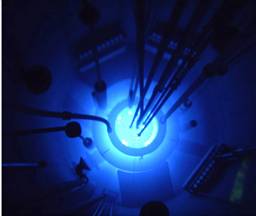|
Archaeometry at OSUís Radiation Center |


|
OSUís TRIGA Reactor |
|
Oregon State Universityís TRIGA Reactor (OSTR) is a water-cooled, Mark III research reactor with graphite shielded core, designed to provide intense radiation fluxes for research and isotope production.† The reactor is licensed by the U.S. Nuclear Regulatory Commission to operate at maximum steady state power of 1.1 MW, generating a peak in-core thermal neutron flux of 1013 n@ cm-2@s-1 and a peak fast neutron flux 5.0 x 1012 n@cm-2@s-1† (E > 1 MeV).† The OSTR operates on a regular schedule, 5 days per week, and provides irradiation and analytical services to other universities and to government and industrial users. Irradiation facilities associated with the OSTR include the Rotary Specimen Rack (or Lazy Susan), located in a circular well within the reflector assembly.† The specimen rack holds up to 40 specimen containers and rotates around the core to provide a uniform neutron exposure with a nominal thermal neutron flux of 3.0 x 1012 n@cm-2@s-1.† In addition, a pneumatic transfer system is available for rapid delivery of small amounts of material to and from the reactor core. The pneumatic system offers a higher thermal neutron flux (1.0 x 1012 n@cm-2@s-1) appropriate for the production of short and intermediate half-life isotopes. |


|
Looking down into the blue glow of the Reactor core. |

|
For more information, visit the OSU Radiation Center home page.† |
